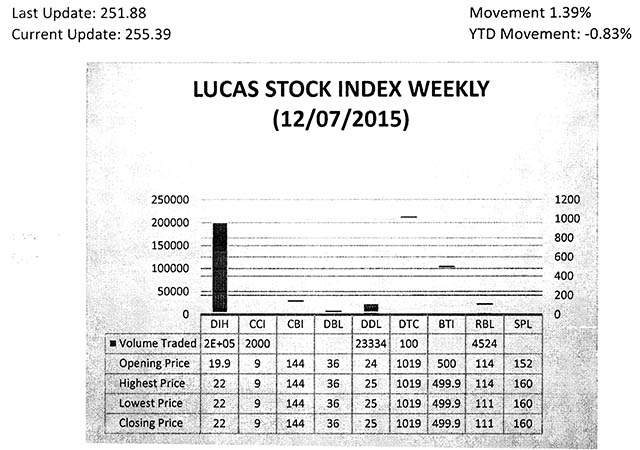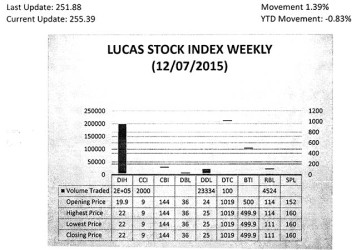Not simple
The revenue challenge facing the new administration is not a simple one. Guyana employs a tax structure with tax rates that should help it yield far more revenue than it currently receives. The tax structure which consists of the share of the various taxes in revenue collection in Guyana is sufficiently broad and refined that one ought to remain surprised at how little is being collected by the authorities. The revenues collected over the last seven years do not necessarily reflect the true amount of revenue that could have been collected. This article focuses on the behaviour of tax revenues from 2006 to 2014 and explores some of the issues that confront the collection of optimum revenues in Guyana. It intends to be forward looking as some thought is given to the need to increase revenue collections using reasonable and rational means. The article will be presented in multiple parts as it seeks to provide readers with enough information about the origins and uses of the tax structure and expectations of revenue collection from it for the New Year.
Bulk of taxes
 The responsibility for revenue collection in Guyana is distributed among several institutions. The National Insurance Scheme collects taxes that are used to meet a variety of social needs of the Guyanese workers or retirees. It also caters for those who suffer misfortunes or disabilities from injuries on the job. It provides a variety of benefits to the contributors to the scheme. The Guyana Forestry Commission (GFC) collects taxes that derive from activities in the forestry sector. Another agency that collects taxes on behalf of the Guyana Government is the Guyana Geology and Mines Commission (GGMC). The GGMC collects taxes that are linked to the mining activities of the country. The bulk of the taxes that are collected in Guyana come through the Guyana Revenue Authority (GRA). It is the revenue activities that are associated with this agency that are of interest to this article.
The responsibility for revenue collection in Guyana is distributed among several institutions. The National Insurance Scheme collects taxes that are used to meet a variety of social needs of the Guyanese workers or retirees. It also caters for those who suffer misfortunes or disabilities from injuries on the job. It provides a variety of benefits to the contributors to the scheme. The Guyana Forestry Commission (GFC) collects taxes that derive from activities in the forestry sector. Another agency that collects taxes on behalf of the Guyana Government is the Guyana Geology and Mines Commission (GGMC). The GGMC collects taxes that are linked to the mining activities of the country. The bulk of the taxes that are collected in Guyana come through the Guyana Revenue Authority (GRA). It is the revenue activities that are associated with this agency that are of interest to this article.
Creation of GRA
The GRA was created by the Revenue Authority Act of 1996. The entity came to life in the year 2000 having absorbed the responsibilities of its two forerunner organizations namely the Inland Revenue Department (IRD) and the Customs and Excise Department (CED). The IRD was responsible for collecting taxes from income. It was responsible also for collecting revenues from licensing operations. At one point in time, items requiring licences included vehicles, bicycles, and radios. The operation of a business and sale of tobacco and alcoholic beverages among others also require possession of a licence, even though the items of focus changed over time with some being eliminated altogether from revenue collection. The CED was responsible for collecting revenues from imported items and for preventing uncustomed goods from entering domestic production and trade.
The rationale for forming a single agency to collect tax revenues hinged on a desire to maximize revenue collection while minimizing collection costs. It was thought that the two independent departments engaged in duplicate functions especially as they related to revenue collection, enforcement against tax evasion and research activities relating to the development of tax policy. Further, taxes that were more aligned with the focus of CED were being collected by the IRD. When concerns of competition between the two agencies for access to competent staff are added to the concerns of efficiency and effectiveness, the decision to bring the two departments together seems logical.
Enhanced powers
The new organization emerged with substantially enhanced powers to collect revenue for the government from a variety of sources. Leaving aside the courts, the GRA is perhaps the only entity that can legally compel persons classified as residents to do what it wants. In addition to the inducements of responsible citizenship, it is these powers of compulsion that encourage many taxpayers to comply with the law and voluntarily participate in the tax collection activities. Yet, on the available evidence, one cannot say with confidence that the government is receiving all of the money that it might be entitled to. This aspect of the story will be examined further later in the article. At this point, it would be useful to discuss the tax structure or the tax tools that are available to the GRA to perform its revenue collection responsibilities on behalf of the Guyana Government.
Variety of taxes
Guyana utilizes a variety of taxes to raise revenue and collectively, these taxes are referred to as the tax structure. The tax structure of Guyana can be classified broadly in five ways. These are the income tax, the property tax, the production and consumption taxes, the trade and travel taxes and a miscellaneous set of taxes that are described as “others”. The income tax itself has four substructures that reflect the tax base to which the structure applies. These are individual income tax, self-employed income tax, tributor’s tax and company taxes. To the extent that companies and corporations are accepted as artificial persons, one can say that the income tax is a tax on personal income that is earned through work. There is some amount of income that is not earned through work. It comes from savings, investments and rental of property. This type of income is often referred to as passive income. The income tax structure is usually directed at this type of income as well.
The property tax is a tax on moveable and immoveable property. Some people describe it as a tax on personal and real property. Given that it is attracted even to one’s personal effects, the tax can be seen as intrusive. It is an activity that is associated with the income tax services of the government and not the Customs side.
The production and consumption taxes have two substructures. These are the value-added tax (VAT) and the excise tax (ET). The VAT is applied to imported items and items that are produced and sold in Guyana. The ET is also applied to imports and some domestically produced items. The imported items that are the target of the excise tax are alcoholic beverages, petroleum products, tobacco and motor vehicles. Unlike the income tax which attacks the income of taxpayers directly, the VAT and ET only do so when taxpayers decide to spend their money. They can be avoided and it is for this reason that the VAT is regarded as an indirect tax.
The international trade and travel taxes are focused on international activities. Most of the revenue generated by the external sector comes from imports and not exports. This source of taxes offers many issues for discussion which will occur later in the article. Another part of the external sector is that of international travel. Outgoing passengers are required to pay a fee before boarding a flight. This fee is sometimes referred to as the departure tax. Then there is the travel voucher tax which is the fee paid by operators in the airline industry.
The final group of taxes is referred to as “others”. This is a miscellaneous set of taxes that relate to the licensing of vehicles and granting persons the right to engage in trading activities.
Various times
These different taxes were introduced at various times in Guyana’s history. Many of them predate independence and are therefore holdovers from the colonial period. The income tax, a major revenue source, for example, was introduced in March 1929. The emergence of the income tax in Guyana occurred in the same year as that of the Great Depression. The two events are not necessarily linked given that the Great Depression began in September 1929, six months after the income tax was introduced in Guyana. Given the timing of its introduction, the income tax appears intended to ease financial transfers to the colony of Guyana. It has survived as a source of revenue and for many years served as a major source of revenue for the government. Independent Guyana kept the income tax as a source of government revenue, thus enabling the instrument to survive for 86 years already.
Some of the miscellaneous taxes that fall under the category of “others” were enacted in the same year as the income tax, while others were enacted in 1940 under the Tax Act and the Motor Vehicles and Road Traffic Act. The property tax is another tax which came into effect while Guyana was still under British rule having been enacted in 1962. (To be continued)
LUCAS STOCK INDEX
The Lucas Stock Index (LSI) rose 1.39 per cent during the first trading period of December 2015. The stocks of five companies were traded with 229,958 shares changing hands. There were two Climbers and one Tumbler. The stocks of Banks DIH (DIH) rose 10.55 per cent on the sale of 200,000 shares. At the same time, the stocks of Demerara Distillers Limited (DDL) rose 4.17 per cent on the sale of 23,334 shares. The stocks of Republic Bank Limited (RBL) fell 2.63 per cent on the sale of 4,524 shares. In the meanwhile, the stocks of Caribbean Container Inc. and Demerara Tobacco Company (DTC) remained unchanged on the sale of 2,000 and 100 shares respectively.











